英语教案Unit2Myschoolbag第二课时
四年级英语上册-Unit2 第2课时 A Learn【教案】
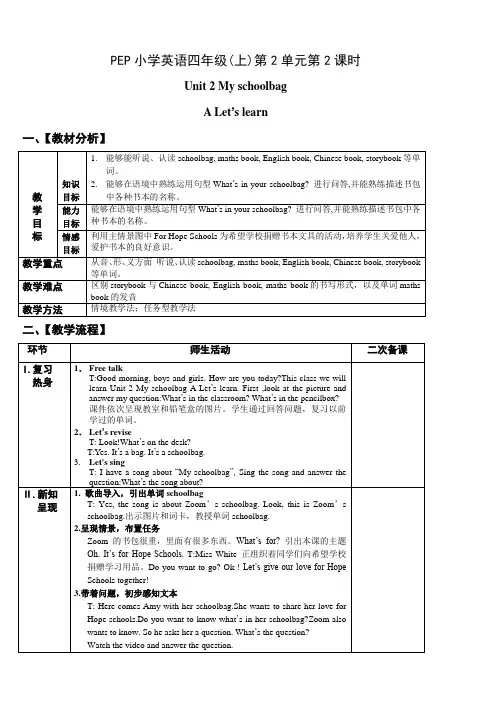
PEP小学英语四年级(上)第2单元第2课时Unit 2 My schoolbagA Let’s learn一、【教材分析】二、【教学流程】长根据同学们的对话内容,做好数量的统计)A: What’s in your schoolbag?B:I have four pens, two storybooks and an English book for Hope Schools.What’s in your schoolbag?C:I have…3.Make a reportThe leader make a report: We have…Ⅴ.总结反馈T:What have we learned in this class?学生用英语或汉语说说本节课学了哪些知识。
Ⅵ.作业布置1.listen to the tape for three times.2.What’s in your schoolbag? Talk about it with your partners.三、【板书设计】Unit 2 My schoolbagA Let’s learnWhat’s in your schoolbag?an English book,a Chinese book,a maths bookthree storybooks四、【教后反思】本节课通过谈论Amy的书包中的物品而呈现了句型“What’s in your schoolbag?”以及schoolbag, maths book, English book, Chinese book和storybook等单词,这部分内容与学生的学习生活息息相关,能激起学生表达的欲望。
因此在设计本节课时,以本单元主情景图中为希望小学捐物这一情境为主要情景,并在这统一的情景下引领学生谈论了Zoom的书包,然后谈论Amy的书包,最后谈论自己的书包,实现了学习语言、操练语言、运用语言等一系列教学目标。
增城市实验小学四年级英语上册Unit2Myschoolbag第2课时教案人教PEP
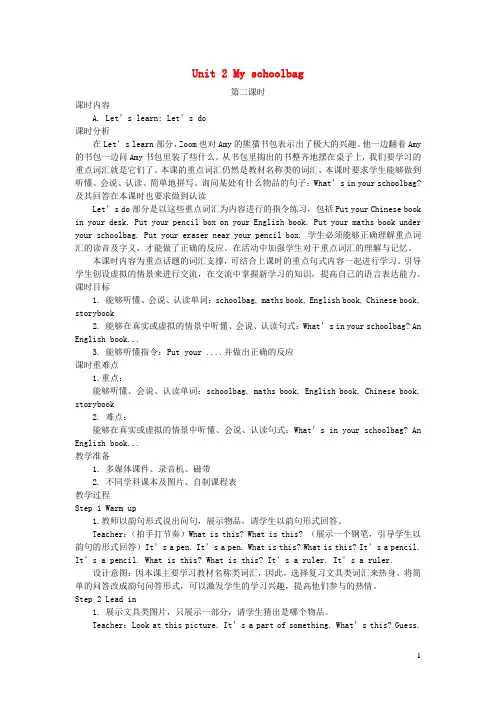
Unit 2 My schoolbag第二课时课时内容A. Let’s learn; Let’s do课时分析在Let’s learn部分,Zoom也对Amy的熊猫书包表示出了极大的兴趣。
他一边翻着Amy 的书包一边问Amy书包里装了些什么。
从书包里掏出的书整齐地摆在桌子上,我们要学习的重点词汇就是它们了。
本课的重点词汇仍然是教材名称类的词汇,本课时要求学生能够做到听懂、会说、认读、简单地拼写。
询问某处有什么物品的句子:What’s in your schoolbag? 及其回答在本课时也要求做到认读Let’s do部分是以这些重点词汇为内容进行的指令练习,包括Put your Chinese book in your desk. Put your pencil box on your English book. Put your maths book under your schoolbag. Put your eraser near your pencil box. 学生必须能够正确理解重点词汇的读音及字义,才能做了正确的反应。
在活动中加强学生对于重点词汇的理解与记忆。
本课时内容为重点话题的词汇支撑,可结合上课时的重点句式内容一起进行学习。
引导学生创设虚拟的情景来进行交流,在交流中掌握新学习的知识,提高自己的语言表达能力。
课时目标1. 能够听懂、会说、认读单词:schoolbag, maths book, English book, Chinese book, storybook2. 能够在真实或虚拟的情景中听懂、会说、认读句式:What’s in your schoolbag? An English book...3. 能够听懂指令:Put your ....并做出正确的反应课时重难点1.重点:能够听懂、会说、认读单词:schoolbag, maths book, English book, Chinese book, storybook2. 难点:能够在真实或虚拟的情景中听懂、会说、认读句式:What’s in your schoolbag? An English book...教学准备1. 多媒体课件、录音机、磁带2. 不同学科课本及图片、自制课程表教学过程Step 1 Warm up1.教师以韵句形式说出问句,展示物品,请学生以韵句形式回答。
《Myschoolbag》第二课时UnitMyschoolbag第二课时
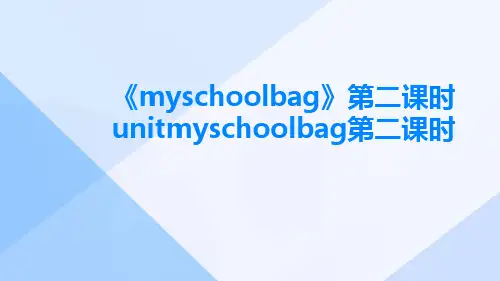
学习新知识
内容
通过图片展示和情境模拟的方式,让学生学习新词汇和句型。
方法
教师出示一些与书包相关的图片,并询问学生:“What’s in your schoolbag?”引导学生回答:“There is…”并展示相应的单词卡。之后,教师出示一个情境模拟图,问:“What’s in your schoolbag today?” 让学生用英语回答。
过程与方法
01
通过观察、比较和归纳等方法,使学生能够自主发现并掌握代 词it的基本用法;
02
通过小组合作学习和任务型教学,培养学生的自主学习能力和
合作意识;
通过情境设计和拓展练习,提高学生的英语运用能力和创新能
03
力。
情感态度与价值观
01
培养学生学习英语的兴趣和自信心;
02
通过情境表演和小组竞赛等活动,增强学生的合作意识和竞争意识;
巩固练习
内容
通过游戏和小组活动的方式,让学生巩固所学知识。
方法
教师组织一个“听音举单词”的游戏,让学生听到单词后迅速举起相应的单词卡。接着,教师组织一 个小组活动,让学生互相询问和回答关于书包里有什么的问题,并记录下来。之后,每个小组选派一 名代表向全班展示和分享他们记录的结果。
拓展延伸
内容
通过设置任务和提供阅读材料的方式,让学生拓展知识面和 阅读能力。
《myschoolbag》第二课时 unitmyschoolbag第二课时
目录
• 教学目标 • 教学内容及重难点 • 教学步骤及方法
01
教学目标
知识与技能
1
掌握代词it的基本用法,并能在实际语境中灵活 运用;
Unit2Myschoolbag第二课时教学设计
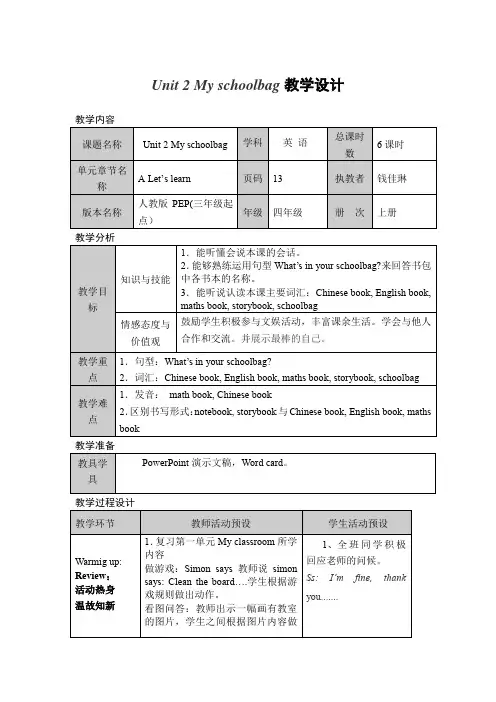
A: I have a new schoolbag.
B: Oh, it's nice. What's in your schoolbag?
A: A pencil-case and many books.
B: How many books do you have?
Put your notebook under your bag.
Put your pencil in your desk.
Put your pencil-case on your chair.
Put your eraser near your pencil-case.
Put your English book on your head.
1、全班同学积极回应老师的问候。
Ss: I’m fine, thank you.......
Lead in
情景导入
1.让学生熟悉句型What’s in your schoolbag?
教师手拿出书包,提问:What is this?
教师出示单词卡,引导学生回答:Schoolbag并让学生指一指自己的schoolbag。
看图问答:教师出示一幅画有教室的图片,学生之间根据图片内容做问答练习。
2.复习与本课内容有关的单词
做游戏:教师先出示图片pencil, pen, pencil-case, ruler, ersaser, crayon, book, sharpener…,请学生说出单词。然后教师出示写有上述单词的卡片让学生读出来,让学生把单词和图片配成一对
Unit2Myschoolbag教学设计
教学内容
课题名称
Unit 2 My schoolbag
Pep小学英语四年级上Unit2Myschoolbag第二课时教案
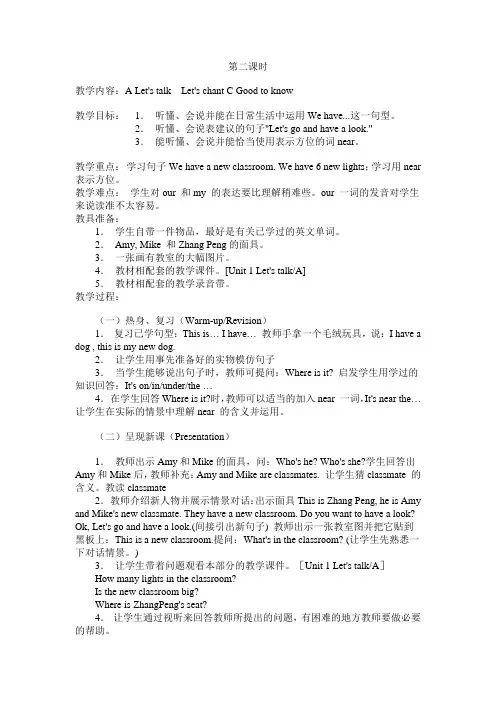
第二课时教学内容:A Let's talk Let's chant C Good to know教学目标:1.听懂、会说并能在日常生活中运用We have...这一句型。
2.听懂、会说表建议的句子"Let's go and have a look."3.能听懂、会说并能恰当使用表示方位的词near。
教学重点:学习句子We have a new classroom. We have 6 new lights;学习用near 表示方位。
教学难点:学生对our 和my 的表达要比理解稍难些。
our 一词的发音对学生来说读准不太容易。
教具准备:1.学生自带一件物品,最好是有关已学过的英文单词。
2.Amy, Mike 和Zhang Peng的面具。
3.一张画有教室的大幅图片。
4.教材相配套的教学课件。
[Unit 1 Let's talk/A]5.教材相配套的教学录音带。
教学过程:(一)热身、复习(Warm-up/Revision)1.复习已学句型:This is… I have… 教师手拿一个毛绒玩具,说:I have a dog , this is my new dog.2.让学生用事先准备好的实物模仿句子3.当学生能够说出句子时,教师可提问:Where is it? 启发学生用学过的知识回答:It's on/in/under/the …4.在学生回答Where is it?时,教师可以适当的加入near 一词,It's ne ar the… 让学生在实际的情景中理解near 的含义并运用。
(二)呈现新课(Presentation)1.教师出示Amy和Mike的面具,问:Who's he? Who's she?学生回答出Amy和Mike后,教师补充:Amy and Mike are classmates. 让学生猜classmate 的含义。
人教版4年级上册英语【教案】Unit2 My schoolbag 第二课时(含教学反思)
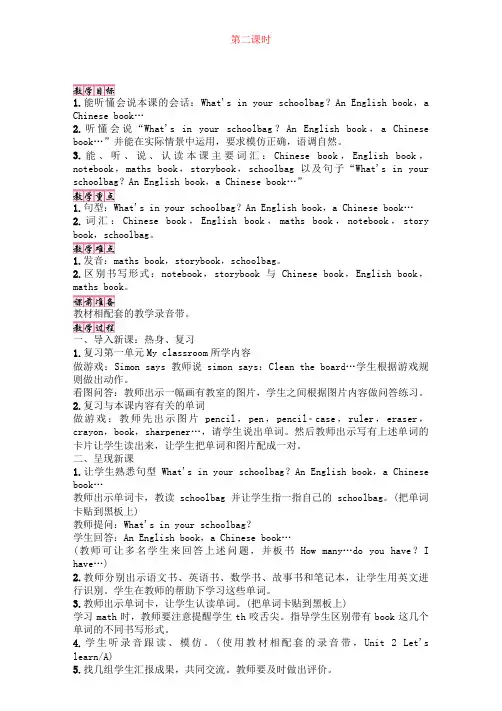
第二课时1.能听懂会说本课的会话:What's in your schoolbag?An English book,a Chinese book…2.听懂会说“What's in your schoolbag?An English book,a Chinese book…”并能在实际情景中运用,要求模仿正确,语调自然。
3.能、听、说、认读本课主要词汇:Chinese book,English book,notebook,maths book,storybook,schoolbag以及句子“What's in your schoolbag?An English book,a Chinese book…”1.句型:What's in your schoolbag?An English book,a C hinese book…2.词汇:Chinese book,English book,maths book,notebook,story book,schoolbag。
1.发音:maths book,storybook,schoolbag。
2.区别书写形式:notebook,storybook与Chinese book,English book,maths book。
教材相配套的教学录音带。
一、导入新课:热身、复习1.复习第一单元My classroom所学内容做游戏:Simon says 教师说simon says:Clean the board…学生根据游戏规则做出动作。
看图问答:教师出示一幅画有教室的图片,学生之间根据图片内容做问答练习。
2.复习与本课内容有关的单词做游戏:教师先出示图片pencil,pen,pencilcase,ruler,eraser,crayon,book,sharpener…,请学生说出单词。
然后教师出示写有上述单词的卡片让学生读出来,让学生把单词和图片配成一对。
小学四年级英语教材解读——Unit2Myschoolbag第二课时教案
IntroductionEnglish is considered as a global language and plays an essentialrole in communication and educational development. Therefore, it is crucial to introduce English as a second language to children at a young age. In China, the primary school curriculum emphasizesteaching English as a second language since year one, and theEnglish textbook gradually introduces different topics andvocabulary that are appropriate for each year level. This articlewill focus on unit two, Lesson 2 of the fourth-year English textbook, titled "My Schoolbag." It will provide an in-depth analysis of the teaching material, teaching objectives, and instructional approaches to help students learn effectively.Teaching Material AnalysisLesson 2 of Unit 2 of the fourth-year English textbook is called "My Schoolbag." This lesson mainly aims to introduce basic vocabularyand sentence structures that students commonly use when talkingabout schoolbags. The teaching material includes different elements such as vocabulary, grammar, listening, speaking, and writing. VocabularyThe vocabulary in this lesson includes words such as schoolbag,pencil case, notebook, ruler, glue, pencil, eraser, pen, marker, and crayon. These words are essential when talking about school supplies and commonly used by students in schools. This lesson alsointroduces "What's in your schoolbag?" as a frequently askedquestion, which helps students practice answering and usingappropriate vocabulary.GrammarThe grammar in this lesson focuses on the use of "have" and "has" to indicate possession. The teacher introduces this grammar element through different examples, such as "I have a pencil," "She has a notebook," and "He has a ruler." This approach helps students understand the usage of "have" and "has" in sentences and apply itin different scenarios.Listening and SpeakingThe listening and speaking components of this lesson includedifferent activities that help students practice their listening and speaking skills. For example, the teacher can ask students to make a list of things they have in their schoolbags and then inviteindividual students to share their list with the class. Thisactivity allows students to practice speaking English in a group setting and develop their listening skills by hearing theirclassmates' answers.WritingThe writing component of this lesson includes a writing task in which students describe what they have in their schoolbags. Thistask encourages students to practice using vocabulary and grammar that they have learned in the class to create sentences. The teacher can also provide feedback on the writing task to help students improve their writing skills.Teaching ObjectivesThe main objective of this lesson is to help students learn vocabulary and sentence structures related to schoolbags. However, there are other objectives that teachers can aim to achieve during this lesson, such as:1.Developing students' listening and speaking skills by engagingthem in different activities that encourage communication.2.Improving students' writing skills by providing opportunitiesfor writing tasks.3.Building students' confidence and motivation in speaking Englishin a group setting.4.Introducing students to basic grammar elements that reinforcethe usage of correct sentence structures.Instructional ApproachesTo achieve the objectives of this lesson, teachers can use different instructional approaches, such as:1.Interactive LearningThe teacher can use interactive learning approaches such as group discussions, role-playing, and games to engage students in the lesson. For example, the teacher can divide the class into groups of three and ask each group to present a skit showcasing what is intheir schoolbag.2.Visual aidsVisual aids such as pictures, videos, and flashcards can be used to enhance students' learning experiences. The teacher can showpictures of different school supplies and ask students to identify them or match them with the corresponding written vocabulary.3.Cross-Curriculum IntegrationThe teacher can integrate the lesson with other curriculum subjects such as science, social studies, and mathematics. For example, the teacher can ask students to calculate the weight of their schoolbags and how much it is compared to their body weight.ConclusionEnglish lessons at the primary school level are essential in developing students' language proficiency and communication skills. The focus of Unit 2 Lesson 2 of the fourth-year English textbook, titled "My Schoolbag," is to introduce students to basic vocabulary and sentence structures related to schoolbags. Teachers can use different instructional approaches, such as interactive learning, visual aids, and cross-curriculum integration, to enhance students' learning experiences and achieve the teaching objectives. By teaching English in a fun and engaging way, students will be motivated to learn and be more confident in communicating in a second language.。
人教PEP版英语四上《Unit2MySchoolbag》教案
人教PEP版英语四上《Unit 2 My Schoolbag》教案一. 教材分析《Unit 2 My Schoolbag》是人教PEP版英语四年级上册的一单元,主题是关于描述书包及书包里的物品。
本节课主要让学生掌握有关学习用品的词汇,如pencil, pen, ruler, eraser等,并能用There be结构描述书包里的物品。
通过本节课的学习,学生能够提高自己的观察力和表达能力。
二. 学情分析四年级的学生已经掌握了基本的日常英语对话,对英语有了一定的兴趣。
但是,部分学生的英语听说能力还有待提高,需要教师在教学过程中给予更多的关注和指导。
此外,学生对于描述物品的词汇和句型还不够熟悉,需要在教学中加强练习和应用。
三. 教学目标1.知识目标:学生能够听懂、会说、会读本节课的重点词汇,如pencil,pen, ruler, eraser等,并能用There be结构描述书包里的物品。
2.能力目标:学生能够在真实情境中运用所学知识进行交流,提高自己的观察力和表达能力。
3.情感目标:培养学生热爱学习,关心他人的良好品质。
四. 教学重难点1.重点:本节课的重点是让学生掌握有关学习用品的词汇,并能用There be结构描述书包里的物品。
2.难点:学生对于There be句型的运用,以及如何正确描述书包里的物品。
五. 教学方法1.任务型教学法:通过设置各种任务,让学生在完成任务的过程中运用所学知识,提高学生的实际运用能力。
2.情境教学法:创设真实的情境,让学生在情境中感受、体验和运用英语。
3.游戏教学法:通过趣味性的游戏,激发学生的学习兴趣,提高学生的学习积极性。
六. 教学准备1.教具:准备书包、学习用品等实物,以及相关的图片、卡片等。
2.课件:制作课件,包括单词卡片、图片、动画等,以便于教学展示。
七. 教学过程1.导入(5分钟)教师通过提问方式引导学生谈论书包,引出本节课的主题。
例如:“What’s in your schoolbag?”, “Can you show me your pen?”, “Is there a ruler in your schoolbag?”等。
Unit2 My schoolbag教案 2024-2025学年人教PEP版四年级上册英语
人教PEP版四年级上册英语《Unit 2 Myschoolbag》教案一、课题名称Unit 2 My schoolbag二、课程课时3 课时三、教材内容分析本单元围绕“书包”这一主题展开,主要学习书包里的学习用品相关词汇,如“book”“pencil”“ruler”等,以及询问物品颜色、数量等的句型,如“What colour is it?”“How many...”等。
教材通过对话、歌谣等多种形式呈现语言知识。
四、核心素养目标1. 语言能力:掌握与书包及学习用品相关的词汇和句型,能在实际情境中进行交流。
2. 文化意识:了解不同国家学生书包的特点和文化。
3. 思维品质:培养学生的分类思维和逻辑思维,如对学习用品进行分类。
4. 学习能力:提高学生自主学习和合作学习的能力,如自主记忆词汇。
五、教学重点、难点1. 教学重点掌握重点词汇:schoolbag、book、pencil、ruler、eraser、crayon 等。
掌握重点句型:What's in your schoolbag? What colour is it? How many...do you have?等。
2. 教学难点词汇中一些相似单词的发音区别,如“ruler”和“eraser”。
能够灵活运用句型进行问答交流。
六、课的类型及主要教学方法1. 课的类型:词汇课、对话课、读写课。
2. 主要教学方法:情景教学法、游戏教学法、歌曲教学法。
七、教学过程第一课时1. 导入环节(5 分钟)教学环节:展示一个漂亮的书包。
教师活动:“Hello, boys andgirls. Look at this beautifulschoolbag. What do you think isin it? Today we are going to learn about schoolbags and the things in them.”学生活动:学生们好奇地看着书包,猜测里面有什么物品。
人教版(PEP)英语四年级上册《Unit2Myschoolbag》单元教案2
人教版(PEP)英语四年级上册《Unit 2 My schoolbag》单元教案 2一. 教材分析《人教版(PEP)英语四年级上册》Unit 2主要围绕学生日常生活中的书包展开,通过学习本单元,学生能够掌握关于学习用品的词汇,如pen, pencil, ruler等,同时学会用英语描述书包里的物品以及询问他人书包里有什么。
本教案主要针对Unit 2的第三课时,以故事情境的形式,让学生在真实语境中学习并运用本单元的核心句型“What’s in your schoolbag?”和“It’s …”。
二. 学情分析四年级的学生已经具备一定的英语基础,能够听懂并简单运用日常英语进行交流。
但部分学生在发音和听力方面还存在一定困难,需要教师重点关注和引导。
此外,学生对本单元话题感兴趣,有利于激发学习积极性。
三. 教学目标1.知识目标:学生能够听懂、会说、会读本单元核心句型“What’s inyour schoolbag?”和“It’s …”,并能用英语简单描述书包里的物品。
2.能力目标:学生能够在图片或情景提示下,运用所学句型进行真实交流。
3.情感目标:培养学生热爱学习、关注生活的情感态度,提高学生团队合作意识。
四. 教学重难点1.重点:掌握本单元核心句型“What’s in your schoolbag?”和“It’s …”,并能运用到实际情景中。
2.难点:正确发音和听力理解。
五. 教学方法1.情境教学法:通过设置情境,让学生在真实语境中学习并运用英语。
2.任务型教学法:通过小组合作完成任务,提高学生交流和实践能力。
3.游戏教学法:通过趣味游戏,激发学生学习兴趣,巩固所学知识。
六. 教学准备1.教材:《人教版(PEP)英语四年级上册》Unit 2第三课时。
2.教具:书包、学习用品、图片、录音机、磁带等。
3.课件:利用多媒体课件,展示本节课的重点内容和情景。
七. 教学过程1.导入(5分钟)教师展示一个书包,引导学生谈论书包里的物品,从而引出本节课的主题。
- 1、下载文档前请自行甄别文档内容的完整性,平台不提供额外的编辑、内容补充、找答案等附加服务。
- 2、"仅部分预览"的文档,不可在线预览部分如存在完整性等问题,可反馈申请退款(可完整预览的文档不适用该条件!)。
- 3、如文档侵犯您的权益,请联系客服反馈,我们会尽快为您处理(人工客服工作时间:9:00-18:30)。
英语教案-Unit2Myschoolbag第二课时教学重点:1.句型:What colour is it? It’s…2.词汇:colour , fat 教学难点:1.发音:What’s colour is it? 2.在回答句子时颜色前面不用冠词,学生经常会出现It’s a red。
这样的错误。
教具准备:1.教师使用的一只玩具熊猫2.教材相配套的教学课件[Unit 2 Let’s learn]3.教材相配套的教学录音带教学过程:(一)热身/复习(Warm-up/Revision)1.做本单元A部分Let’s do内容,听指令做动作。
2.复习上一课内容:看单词卡,读单词:English book,Chinese book, math book , notebook, story-book。
做对话:How many books do you have? I have…3.教师播放录音,学生模仿录音进行对话。
(使用第一册相配套的教学录音带Unit4 Let’s talk/B)A: I have a …B: Oh, really? May I have a look? A: Sure。
Here you are。
B: Thank you。
Oh, it’s nice! I like it。
A: Thanks。
(二)呈现新课(Presentation)1.如果在前面做的对话中,有学生说出:I have a new schoolbag。
这时教师要利用这一契机追问:Really? What colour is it? 如果没有学生说出与课文相关的句子,教师可进行以下操作:教师手中拿一个书包,说:I have a new schoolbag。
It’s black and white。
让学生听两遍后,问学生:What colour
is it? 如果学生一时回答不出来,教师可用以下句子进行引导:Is it black/red/blue?当学生说出颜色的词时,教师说完整句It’s …让学生重复。
2.让学生用身边的物品做What colour is it? It’s…的问答练习。
(注意颜色前面不能用冠词,对学生说出的句子It’s a blue。
教师要随时给与纠正)3.教师出示一只玩具熊猫,问学生:What’s this?对能够回答出来的学生进行表扬,如果没有学生能说出来,教师:It’s a panda。
It’s a fat panda。
在说句子时,教师要用手势帮助学生理解fat一词。
让学生看着熊猫重复教师刚才说的句子。
4.教师指着熊猫,与学生做问答。
教师:What colou is it? 学生:It’s black and white。
教师:How nice!(教师说此句时,尽量把语气夸张些,让学生理解句子的意思。
)5.让学生模仿着做这组对话。
6.让学生观看本部分教学课件。
[Unit 2 Let’s talk/A]7.让学生根据视听内容,判断对错。
Chen Jie has a new schoolbag。
Many books in the schoolbag。
An English book, a notebook, and…The panda is fat and nice。
第一句错误,应为Amy has a new schoolbag。
第二句错误,应为Many books in the schoolbag。
An English book, a story-book, and…第三句正确。
8.听录音带,跟读并模仿。
(使用相配套的教学录音带,Unit 2 Let’s talk/A)
9.观看课件,让学生给人物配音。
10.让学生分小组表演对话。
教师可让学习好的学生在课文的基础上,自编对话。
对学习好的同学要提高要求。
11.学生汇报练习结果,教师要进行评价。
(三)趣味操练(Practice)游戏1 猜颜色两个学生一组。
一个学生手拿一件东西放在身后,对另一个学生说:I have…另一个学生说:Really? What colour is it? 手拿东西的学生说:Guess! 然后那个学生来猜东西的颜色:It’s …手拿东西的学生用Yes/No 来判断对错。
直到那个学生猜对为止。
然后两个学生互换角色继续游戏。
游戏 2 遵守交通规则小组活动。
一个学生来当交通指示灯,其他人可在不同时间用What colour is it?向这个学生询问指示灯的颜色,并要根据指示灯回答的颜色做出通行、停止和放慢的动作。
例如:有一个学生问指示灯:What colour is it? 指示灯回答:It’s green。
这时大家可随便行走。
忽然,有一个学生又问:What colour is it? 回答:It’s red。
那这时大家必须停止走动。
如果有学生做错了,就要与当指示灯的学生交换位置,继续游戏。
(四)扩展性活动(Add-activities)可结合第一单元所学内容,让学生互相用What colour is it?询问教室里的墙、门窗、黑板、电扇等物品的颜色并做相应的回答。
使学生在真实的情景中运用和掌握所学知识。
板书设计:Unit 2 My schoolbag What colour is it? It’s …
教案点评:本课时主要通过情景学习句型What colour is it? Its。
以为对话中涉及到May I have a look? Here you are。
而在第一册Unit 4学生已经学过,但因为不常用,教师在这里有必要引导学生先复习一下。
这样学生不会感觉突兀,有助于刚好的理解对话。
而且可以旧带新,在教师的启发下引出本课主要语言点的学习。
在新知学习过程当中,针对一些难点,教师可以通过实物或手势帮助学突破生理解。
在通过猜颜色和遵守交通规则两个趣味游戏巩固What colour is it?的学习。
最后结合第一单元所学的关于教室的内容,学生充分练习询问颜色及其回答的句型,在真实语境中运用和掌握所学。
记忆物品的探究活动探究内容:Whats in it? 活动目的:通过这项活动,能够使学生正确的运用英语来表述身边物品。
并培养学生的记忆能力。
活动方式:师生集体活动活动过程:1、教师准备一个盒子,让学生分别把自己的铅笔、橡皮、尺子等学习用具放到盒子里并请其他学生记住盒子里的东西。
2、教师问学生Whats in it? 对回答对的学生给与奖励。
3、然后教师再让几个同学继续往盒子里放学习用具,继续whats in it? 4、教师不停的让学生往盒子里放东西并问同样的问题。
5、最后看谁能够说出盒子里所有的东西。
